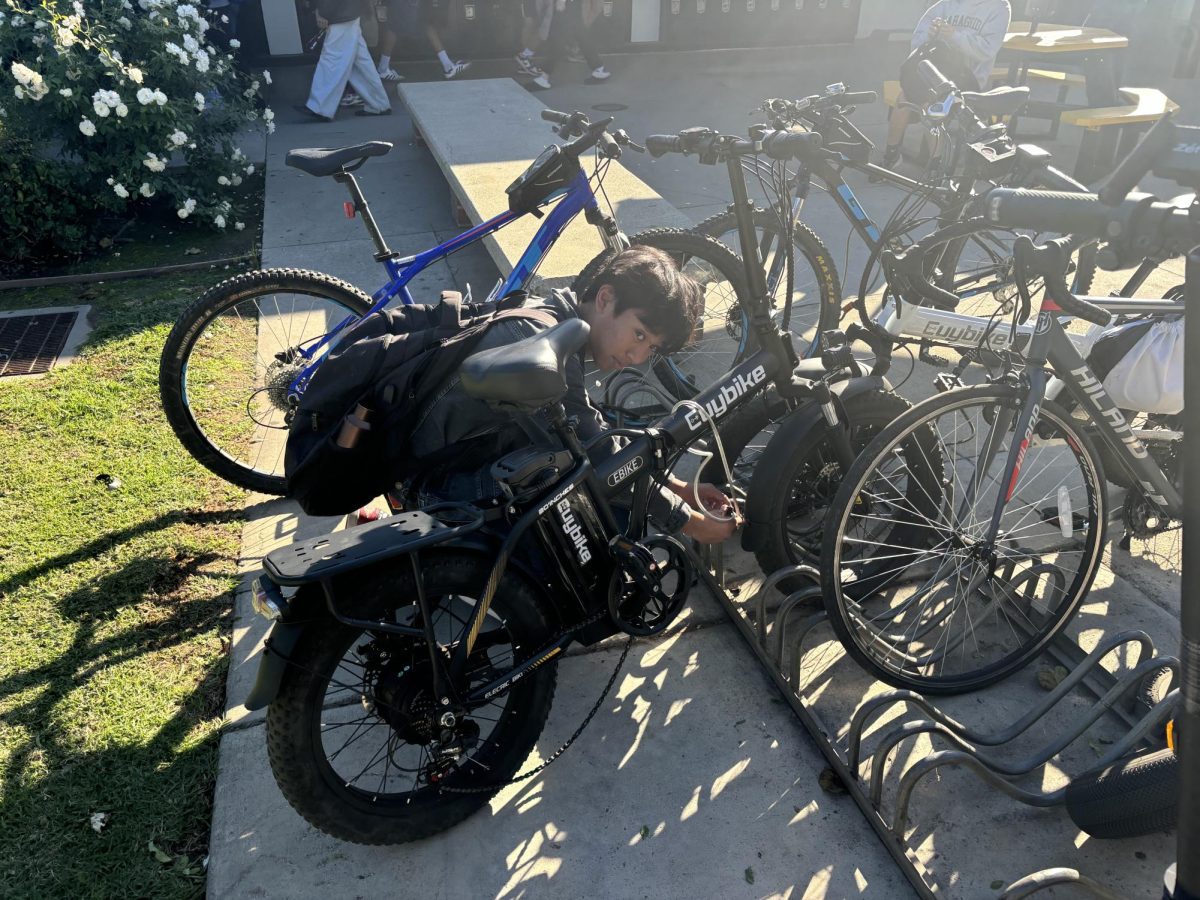Faster than a speeding porker.
More expensive than an iPhone 16.
Able to travel 50 miles in a single charged battery pack.
Look, down the road on Nicholas Street!
It can’t be a bird or a plane or Superman of the 1950s TV series that starts in a similar manner.
It’s gotta be an … e-bike.
Since the return of in-person instruction after the COVID-19 pandemic, this alternative mode of transportation to and from high schools has been trending. High school media in California, for example, have reported an increase in the number of students choosing to ride e-bikes over the traditional two-wheeled cycle requiring users to pedal with their feet.
Brian Bartter, who works at Fullerton Electric Bicycles, said he has also noticed a drastic increase in e-bike purchases among teens.
“I started working around the pandemic, and there was a huge increase [of e-bikes] sales right around that time,” Bartter said. “It has gone down as of now, but there are still more [e-]bike purchases currently than before the pandemic.”
The prices of these alternative forms of transportation range from the cheapest being $1,599.99 – Electra Cruiser Go! Step-Thru, which goes up to 40 miles on a full charge with a speed of 20 miles per hour, to $13,999.99 – Giant Trance X Advanced E+ Elite 0, which goes up to 60 miles on a full charge with a speed well over 30 miles per hour.
Sophomore Jolien Naeim comes to Sunny Hills on her Akez e-bike her mom paid $1,500 for two years ago. Though she’s among the few girls who use this speedier ride, she said that was not the case at her previous high school in Irvine.
“Everyone, including all my friends, had e-bikes when I used to go to Woodbridge High School, so that made me want to get one, too,” she said. “At my old school, everything is so far, so I would e-bike to Target instead of walking for hours.”
Based on an informal count taken on Thursday, Oct. 31, the racks in the freshman hall and between the 50s and 70s wing had nine parked e-bikes/e-scooters.
Science teacher Andrew Gartner, who has been riding his e-bike to campus three times a week for two years, said he noticed more SH students opting for alternative ways to commute to and from campus.
“I definitely think the e-bike trend will become more common,” Gartner said. “Rather than riding an electric vehicle, electric bikes use so much less electricity and produce less waste and air pollution.”

THE LEGAL AND SAFETY ISSUES OF E-BIKES
However, the science instructor, who teaches five periods of Advanced Placement Environmental Science, said this new way of commuting may be hazardous.
“Crowding and making sure students don’t get hit while biking is definitely a concern,” he said. “It may be helpful for campus administrators to establish rules for the bikers’ safety.”
Naeim said the most important rule that riders should follow resides in the use of helmets, especially after her experience from her accident three months ago while riding an e-book to school. Her e-bike rolled over a puddle of water, causing the bike’s front wheels to flip up.
“I was riding the bike, and I fell over and hurt my leg a little,” she said. “I wasn’t wearing a helmet, so it was pretty dangerous since I thought I would hit my head, but thankfully I didn’t.”
As a result of the scare, Naeim said she learned an important lesson to always wear a helmet when on her e-bike.
“I knew that it was a law to wear helmets while riding, but I forgot that day, and now I make sure to wear my helmet at all times,” the sophomore said.
Besides the helmet requirement for all bicyclists on the road, California’s 2023 E-Bikes on Bike Paths law, which also applies to those who ride an e-scooter, states that riders must be 16 years or older.
“I ride my bike to school because my parents can’t take me to school since they have work,” said freshman Florenzo Tenazas, who received his first bike, which cost $699, from Amazon this summer as a birthday gift.
Although Tenazas does not reach the age requirement to ride an e-bike, he said he plans to continue to utilize this mode of transportation.
“I did not know the minimum age to ride an e-bike was 16, and now that I do know I will not change my mind to use it for school because I ride with my brother, who is almost 16, and we know most of the road rules to stay safe,” he said.
ANOTHER ALTERNATIVE TO E-BIKES
Junior Pierrce Sandle said he prefers to ride his Aovopro e-scooter, which can reach 25 miles per hour and around 20 miles on a fully charged battery.
“I started using my electric scooter this summer because I had summer school, and I live close enough to the school, so I don’t really need a car,” Sandle said. “My father, an assistant basketball coach at [the] University of San Diego, got a discount from [that college] and bought the scooter for $150.”
The junior expects more of his peers will follow his lead in their choice of transportation.
“I think e-scooters will be more of a trend because of how easy they are to travel with since they are much lighter than a heavy [e-]bike,” Sandle said.














